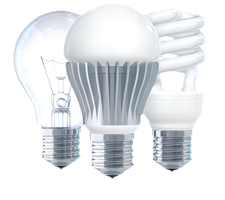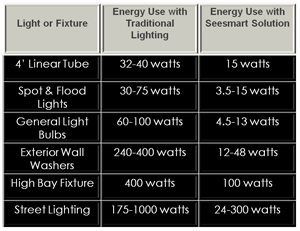What is a LED?

A Light Emitting Diode (LED) is an electronic device that produces light when an electrical current is
passed through it. The wavelength (or color) of light that is emitted is dependent on the materials
from which the LED is made. LEDs are available in many colors, including red, blue, amber, green,
and near-UV colors, with lumen outputs ranging from 10 lumens to 200 lumens.
The LEDs used predominantly in general illumination applications are "Phosphor Converted Blue"
LEDs, which are blue LEDs that have a layer of yellow phosphor placed over the LED. The
phosphor absorbs some of the blue light, and emits yellow light. When the unabsorbed blue light
mixes with the yellow light it creates what your eye perceives as "white" light.
Is LED technology environmentally friendly?
LED lamps are not harmful to the environment, unlike fluorescent technology which contain mercury and other gases. LED lamps do not need to be recycled for proper disposal.
Power Consumption
- Energy savings can extremely impact operation costs. Savings can be delivered through the installation of new efficient LED Lamp technologies which consume only 50% +/- of what the conventional lighting system consumes. All existing lamps and fixtures should be considered for replacement, retrofit or upgrade to maximize energy savings.
Lifetime
- Durable LED Lamps last 5 to 10 times longer than conventional light sources and exceed
50,000 hours of rated lifetime (that is over 17 years of 8 hours of ignition per day). Thus the re-lamping costs can be cut it to a fraction of what is currently being spent on maintenance costs or virtually eliminated. Those costs also apply to purchasing administration, logistics, warehousing, disposal etc.

Maintenance
- The cost occurring during temporary suspension of operation because of lighting system maintenance will not be simple to calculate. The over head costs related with maintenance include costs of salary, training, logistics and insurance could be calculable. Other costs if you are currently contracting out the maintenance include the cost of changing out ballasts and lamps when needed, especially in those hard to reach locations. However, the total maintenance costs will often exceed energy savings. LED Lamps can help users minimize maintenance costs in terms of its longer lifetime.
Wearing Parts
- Unique power design of LED Lamps can completely avoid the damage of delicate components such as filaments or electrodes that are the primary causes of lamp failure in conventional light sources including HID, Halogen, Incandescent and Fluorescent lamps. Replacement for LED Lamps is therefore not required at all after vibration, accidental collision or weather storms and long time of ignition as well.
Heat
- Less heat generating from LED Lamps can reduce a lot of cost including lighting fixture maintenance costs and HVAC operation costs from ambient inefficient heat loss.
Color Perceived
- Good color rendering index (CRI) is crucial to visibility, safety and comfort. LED Lamps having a natural color of light can illuminate much better than most conventional light sources. Because light color can greatly change appearance, aesthetics and attractive qualities color options should be an important factor when considering and evaluating light quality.
Hot Strike
- LED Lamps have good performance of instant re-strike without warming up which will ensure that there isn't any additional utility costs from temporary suspensions of power supply. This all will ensure safety and security for those applications where instant re-strike is required.
Cold Ignition
- LED Lamps can be ignited even under much colder circumstances with temperatures lowering to -20 degrees C/-68 degrees F, thus being a preferable light source for cold storages and outdoor lighting applications in cold areas.
Flicker and Glare
- Without flicker and glare LED Lamps can dramatically improve productivity, readability, eyesight and headaches when comparing with conventional light sources including HID and Fluorescent Lamps that generate much flicker.
Noise
- With a very quiet and silent design LED Lamps can make users comfortable without a humming or buzzing.
 A Light Emitting Diode (LED) is an electronic device that produces light when an electrical current is
passed through it. The wavelength (or color) of light that is emitted is dependent on the materials
from which the LED is made. LEDs are available in many colors, including red, blue, amber, green,
and near-UV colors, with lumen outputs ranging from 10 lumens to 200 lumens.
A Light Emitting Diode (LED) is an electronic device that produces light when an electrical current is
passed through it. The wavelength (or color) of light that is emitted is dependent on the materials
from which the LED is made. LEDs are available in many colors, including red, blue, amber, green,
and near-UV colors, with lumen outputs ranging from 10 lumens to 200 lumens.




